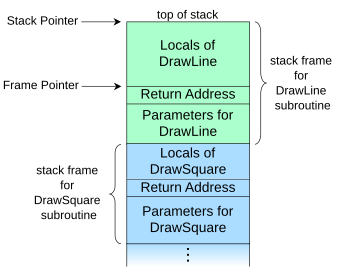What exactly is the base pointer and stack pointer? To what do they point?
Using this example coming from Wikipedia, in which DrawSquare() calls DrawLine():

(Note that this diagram has high addresses at the bottom and low addresses at the top.)
Could anyone explain to me what ebp and esp are in this context?
From what I see, I'd say the stack pointer points always to the top of the stack, and the base pointer to the beginning of the current function? Right?
edit: I mean this in the context of Windows programs.
edit2: And how does eip work, too?
edit3: I have the following code from MSVC++:
var_C= dword ptr -0Ch
var_8= dword ptr -8
var_4= dword ptr -4
hInstance= dword ptr 8
hPrevInstance= dword ptr 0Ch
lpCmdLine= dword ptr 10h
nShowCmd= dword ptr 14h
All of them seem to be dwords, thus taking 4 bytes each. So I can see there is a gap from hInstance to var_4 of 4 bytes. What are they? I assume it is the return address, as can be seen in the diagram from Wikipedia.
(editor's note: removed a long quote from Michael's answer, which doesn't belong in the question, but a followup question was edited in):
This is because the flow of the function call is:
- Push parameters (hInstance, etc.)
- Call function, which pushes return address
- Push ebp
- Allocate space for locals
My question (last one, I hope!) now is, what exactly happens from the instant I pop the arguments of the function I want to call up to the end of the prolog? I want to know how the ebp, esp evolve during those moments (I already understood how the prolog works, I just want to know what is happening after I pushed the arguments on the stack and before the prolog).
esp is as you say it is, the top of the stack.
ebp is usually set to esp at the start of the function. Function parameters and local variables are accessed by adding and subtracting, respectively, a constant offset from ebp. All x86 calling conventions define ebp as being preserved across function calls. ebp itself actually points to the previous frame's base pointer, which enables stack walking in a debugger and viewing other frame's local variables to work.
Most function prologs look something like:
push ebp ; Preserve current frame pointer
mov ebp, esp ; Create new frame pointer pointing to current stack top
sub esp, 20 ; allocate 20 bytes worth of locals on stack.
Then later in the function you may have code like (presuming both local variables are 4 bytes)
mov [ebp-4], eax ; Store eax in first local
mov ebx, [ebp - 8] ; Load ebx from second local
FPO or frame pointer omission optimization which you can enable will actually eliminate this and use ebp as another register and access locals directly off of esp, but this makes debugging a bit more difficult since the debugger can no longer directly access the stack frames of earlier function calls.
EDIT:
For your updated question, the missing two entries in the stack are:
nShowCmd = dword ptr +14h
hlpCmdLine = dword ptr +10h
PrevInstance = dword ptr +0Ch
hInstance = dword ptr +08h
return address = dword ptr +04h <==
savedFramePointer = dword ptr +00h <==
var_4 = dword ptr -04h
var_8 = dword ptr -08h
var_C = dword ptr -0Ch
This is because the flow of the function call is:
- Push parameters (
hInstance,PrevInstance,hlpCmdLine,nShowCmd) - Call function, which pushes return address
- Push
ebp - Allocate space for locals
- clear buffer cache on Mac OS X
- Why does a global statically initialized variable have a different value when debugging? / Why is my debugger loading different code to my device?
- Is void a data type in C?
- Given an array return any index on which its dominator occurs
- Getting the "real" parent process in case process spawned indirectly using launchd
- How do I convert an X11 keycode to a Unicode character in C?
- Getting inflated results when trying to find newline '\n' in a char array in C
- How to calculate a SHA-512 hash in C++ on Linux?
- Coding a website in C?
- .exe file is not being created in Windows for C by cmd by GCC compiler
- How can I simulate an EOF?
- gcc-arm-none-eabi 11.3 "is not implemented and will always fail"
- What is this #ifdef __GNUC__ about?
- OS-9 Programming in C
- File Rename Function on Microware OS-9
- How to convert from UTC to local time in C?
- Why is the tm_year member in struct tm relative to 1900 rather than 1970 in C on macosx?
- Grading system by using switch statement
- Can someone explain to me this piece of code? (pointer arithmetics with masks)
- Avoid trailing zeroes with printf()
- Too many fonts when enumerating with EnumFontFamiliesEx function
- What causes the "identifier NULL is undefined" error?
- What is the full "for" loop syntax in C?
- Fatal error 'stdio.h' not found
- Is it safe to cast size_t to unsigned long int?
- Reproducing buffer overflow
- Simpler way of sorting three numbers
- If I don't specify srand(), what seed does rand() use?
- Computing 2¹²⁸ % uint64_t
- How can I use atomic variables in C?